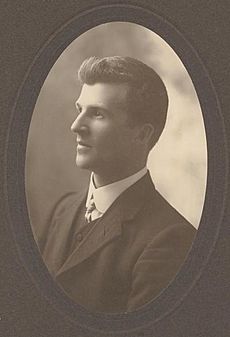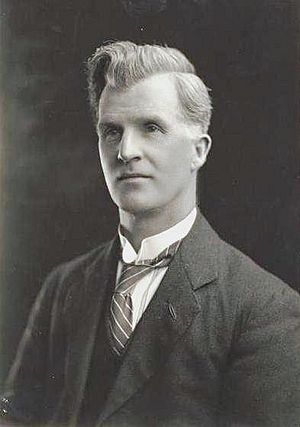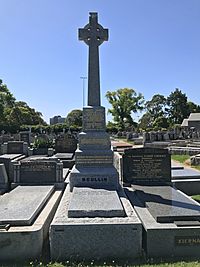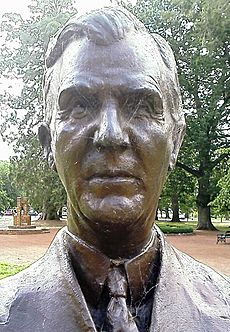James Scullin facts for kids
Quick facts for kids
James Scullin
|
|||||||||||||||||||||||||||||
|---|---|---|---|---|---|---|---|---|---|---|---|---|---|---|---|---|---|---|---|---|---|---|---|---|---|---|---|---|---|
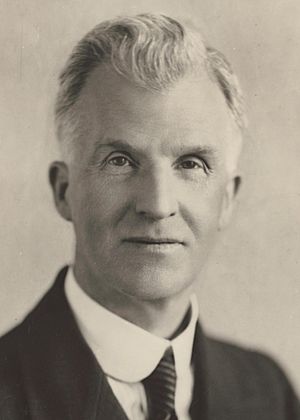
Scullin c. 1930s
|
|||||||||||||||||||||||||||||
| 9th Prime Minister of Australia | |||||||||||||||||||||||||||||
| In office 22 October 1929 – 6 January 1932 |
|||||||||||||||||||||||||||||
| Monarch | George V | ||||||||||||||||||||||||||||
| Governor General |
|
||||||||||||||||||||||||||||
| Deputy | Ted Theodore | ||||||||||||||||||||||||||||
| Preceded by | Stanley Bruce | ||||||||||||||||||||||||||||
| Succeeded by | Joseph Lyons | ||||||||||||||||||||||||||||
| 8th Leader of the Opposition | |||||||||||||||||||||||||||||
| In office 6 January 1932 – 1 October 1935 |
|||||||||||||||||||||||||||||
| Prime Minister | Joseph Lyons | ||||||||||||||||||||||||||||
| Deputy | Frank Forde | ||||||||||||||||||||||||||||
| Preceded by | Joseph Lyons | ||||||||||||||||||||||||||||
| Succeeded by | John Curtin | ||||||||||||||||||||||||||||
| In office 29 March 1928 – 22 October 1929 |
|||||||||||||||||||||||||||||
| Prime Minister | Stanley Bruce | ||||||||||||||||||||||||||||
| Deputy | Arthur Blakeley Ted Theodore |
||||||||||||||||||||||||||||
| Preceded by | Matthew Charlton | ||||||||||||||||||||||||||||
| Succeeded by | John Latham | ||||||||||||||||||||||||||||
| Leader of the Labor Party | |||||||||||||||||||||||||||||
| In office 26 April 1928 – 1 October 1935 |
|||||||||||||||||||||||||||||
| Deputy |
|
||||||||||||||||||||||||||||
| Preceded by | Matthew Charlton | ||||||||||||||||||||||||||||
| Succeeded by | John Curtin | ||||||||||||||||||||||||||||
| Deputy Leader of the Labor Party | |||||||||||||||||||||||||||||
| In office 17 March 1927 – 29 March 1928 |
|||||||||||||||||||||||||||||
| Leader | Matthew Charlton | ||||||||||||||||||||||||||||
| Preceded by | Albert Gardiner | ||||||||||||||||||||||||||||
| Succeeded by | Arthur Blakeley | ||||||||||||||||||||||||||||
|
|||||||||||||||||||||||||||||
|
|||||||||||||||||||||||||||||
| Personal details | |||||||||||||||||||||||||||||
| Born |
James Henry Scullin
18 September 1876 Trawalla, Colony of Victoria |
||||||||||||||||||||||||||||
| Died | 28 January 1953 (aged 76) Melbourne, Australia |
||||||||||||||||||||||||||||
| Resting place | Melbourne General Cemetery | ||||||||||||||||||||||||||||
| Political party | Labor | ||||||||||||||||||||||||||||
| Spouse |
Sarah McNamara
(m. 1907) |
||||||||||||||||||||||||||||
| Education | Mount Rowan State School | ||||||||||||||||||||||||||||
| Occupation |
|
||||||||||||||||||||||||||||
James Henry Scullin (born 18 September 1876 – died 28 January 1953) was an Australian politician. He was the ninth Prime Minister of Australia from 1929 to 1932. He led the Australian Labor Party (ALP) during this time.
Scullin was also the 13th Treasurer of Australia for a short period. He was the first Catholic and the first Irish-Australian to become Prime Minister. His time in office was greatly affected by the Wall Street Crash of 1929. This event happened just two days after he became Prime Minister and started the Great Depression in Australia. Even after his time as Prime Minister, Scullin remained an important figure in the Labor Party until he retired from federal parliament in 1949.
Contents
Early Life and Education
James Scullin was born in Trawalla, Victoria, on 18 September 1876. His parents, John and Ann Scullin, were Irish Catholics. His father worked on the railway. James was the fourth of eight children. He grew up in a close and religious family.
He went to Trawalla State School from 1881 to 1887. People knew him as an active and smart boy. The family moved to Mount Rowan, Ballarat, in 1887. James went to Mount Rowan State School until he was 12.
After school, he did various odd jobs in Ballarat until about 1900. For ten years after that, he ran a grocery shop in Ballarat. In his mid-20s, he went to night school and read a lot. He taught himself many things.
Joining Societies and Politics
Scullin joined several groups, including the Australian Natives' Association and the Catholic Young Men's Society. He became president of the latter. He was also a very good debater. He took part in local competitions for almost 30 years. This helped him develop his interest and skills in politics. Scullin was a devoted Roman Catholic.
He became active in politics while living in Ballarat. He was influenced by Tom Mann and the growing labour movement. In 1903, he became a founding member of his local Political Labor Council. He worked as a campaigner for the Australian Workers' Union. He often spoke about political issues around Ballarat. He also helped with Labor campaigns at state and federal levels.
In the 1906 Australian federal election, he ran as the Labor candidate for the Division of Ballaarat. He was running against the Prime Minister, Alfred Deakin. Even though Labor had little chance of winning, Scullin ran a strong campaign. He impressed many people in the Labor movement.
Marriage and Family Life
On 11 November 1907, James Scullin married Sarah Maria McNamara. She was a dressmaker from Ballarat. They did not have any children.
James Scullin often had serious illnesses throughout his long career. Sarah was a crucial source of support and care for him. She often helped or stood in for him at social events when he was too ill to attend. Sarah was also an active member of the Labor Party. She stayed well-informed about politics. It was unusual for a political spouse at that time, but Sarah often attended parliamentary sessions. She was even there when her husband's government lost a vote.
Political Career and Challenges
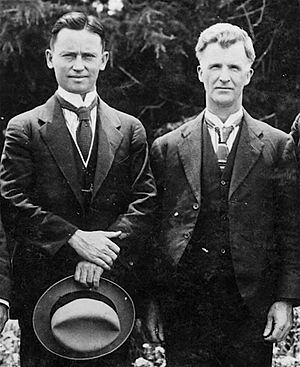
James Scullin was first elected to the Australian House of Representatives in 1910. He was elected again in 1922 and served until 1949. He quickly became an important voice in parliament. He rose to become deputy leader of the Labor Party in 1927. Then, in 1928, he became Leader of the Opposition.
After Scullin won a big election victory in 1929, things changed dramatically. The Wall Street Crash happened, and the Great Depression quickly spread around the world. Australia, which owed a lot of money, was hit very hard.
Scullin and his Treasurer, Ted Theodore, tried to fix the economy. They made plans in 1930 and 1931 to repay foreign debt. They also wanted to help farmers and create jobs. Their ideas involved the government spending money even if it meant borrowing (called deficit spending) and increasing the money supply (called expansionary monetary policy).
In 1931, these ideas were seen as very new and risky. Many people feared they would cause prices to rise too quickly. The Australian Senate, which was controlled by the opposition, and conservative banks blocked Scullin's plans.
With the government facing bankruptcy, Scullin had to change his approach. He supported the Premiers' Plan. This plan was more conservative and involved big cuts to government spending. Pensioners and other Labor supporters were badly affected by these cuts. This led to a lot of disagreement and some politicians leaving the party. After several months of arguments, Scullin's government collapsed. It was heavily defeated by the new United Australia Party in the 1931 Australian federal election.
Scullin remained the Labor Party leader for four more years. He lost the 1934 election. The party only fully recovered after Scullin stepped down as leader in 1935. He became a respected senior figure in the party. He was an expert on taxation and government finance. He played a big role in reforming these areas when Labor returned to government in 1941. Even though he was disappointed with his own time as Prime Minister, he lived long enough to see many of his government's ideas put into action by later governments.
Death and Funeral
James Scullin died in his sleep on 28 January 1953 in Melbourne. He passed away from problems related to pulmonary edema, which affects the lungs. He had a state funeral at St Patrick's Cathedral, Melbourne. He was buried in the Catholic section of Melbourne General Cemetery.
The Labor movement of Australia built a monument over his grave. The words on it say: "Justice and humanity demand interference whenever the weak are being crushed by the strong." Scullin's wife, Sarah, was buried with him in 1962.
Legacy and Impact
Scullin always defended his actions as Prime Minister. He was proud to have been Prime Minister during such difficult times. He lived to see many of his economic ideas proven right. For example, his idea of using government spending to boost the economy was considered radical then. But it later became a key part of Keynesian economics. This approach was adopted by Australia and many other Western governments in the late 1930s and 1940s.
Even John Maynard Keynes, a famous economist, said that Scullin's Premiers' Plan "saved the economic structure of Australia." The Economist magazine also admitted after the 1931 election that Scullin "had already done much to place Australia on the high road to recovery."
Some of the measures Scullin had proposed, but which the opposition blocked, were later passed by the new government. This gave Scullin some satisfaction. He also found comfort in knowing that the Great Depression ended the political careers of most leaders who were in power during it.
In 1951, 114 manufacturers in Melbourne raised money for Scullin's retirement. They remembered his support for tariffs (taxes on imported goods) during the Depression. These companies said that Scullin's efforts had "commenced a new era in the secondary industry field in Australia." They believed that Australia's successful wartime industry was thanks to Scullin protecting local industries years earlier.
Scullin's years after being Prime Minister were also important. He had a surprising amount of influence on government policy as the Opposition Leader. For decades, Scullin was the top expert in the Australian parliament on taxation and other money matters. His advice was very important to the Curtin government. Many of his ideas, which were rejected during his own time as Prime Minister, were later put into law by the Curtin and Chifley governments.
Scullin was a highly respected figure in politics. Even though people disagreed with his policies, he was personally well-regarded. He had a reputation as a brave and strong leader with great honesty. When he resigned as leader in 1935, even his long-time critic Jack Beasley said that Scullin was "a fearless fighter in the exposition of what he believes to be the right course."
The suburb of Scullin, Australian Capital Territory in Canberra is named after him. So is the Division of Scullin, an area for federal elections. The Scullin monolith in Antarctica was also named in his honor.
Images for kids
-
New Prime Minister James Scullin and former Prime Minister Stanley Bruce hold a private meeting after Scullin's swearing-in as Prime Minister, 1929
-
Scullin with Treasurer Ted Theodore in December 1929
-
Parliament House portrait of Scullin by William Beckwith McInnes, 1938
-
Scullin on the day he handed the reins of power to Joseph Lyons, January 1932.
See also
 In Spanish: James Scullin para niños
In Spanish: James Scullin para niños
- Scullin Ministry


